Crassula Tetragona (Miniature Pine Tree) Profile
Written by Iris
Oct 22 2021
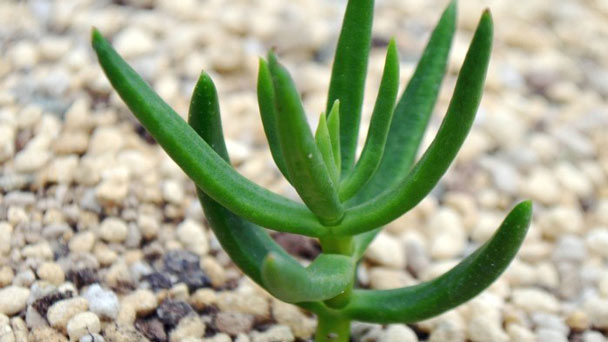
Crassula Tetragona also known as (Miniature pine tree) is a unique and unusual succulent in the Crassula family. Crassula Tetragona has earned the nickname "miniature pine" for its needle-like leaves and branching structure. As the Crassula Tetragona succulent matures, its stem becomes woodier. Given enough space, Crassula Tetragona can grow quite tall, but will be happy in a smaller pot. Crassula Tetragona is great for adding height and texture to mixed succulents. In spring and summer, Crassula Tetragona produces small clusters of delicate cream and white flowers.
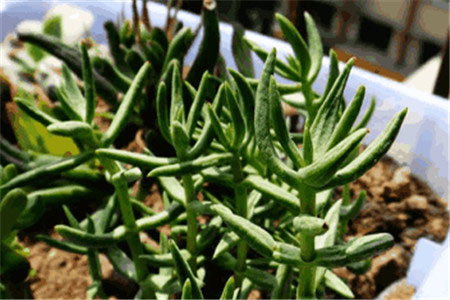
Like most succulents, Crassula Tetragona prefers fast drainage, whether grown in gardens or containers. Water it occasionally in summer, and sparingly in winter. Crassula Tetragona prefers full sun, but in hot climates requires midday shade. Crassula Tetragona will tolerate a couple of degrees of frost. Remove spent flower clusters to improve appearance and prevent seedlings (this species has escaped gardens in California via self-sowing). Potted plants may be kept indoors over winter, or grown as house plants.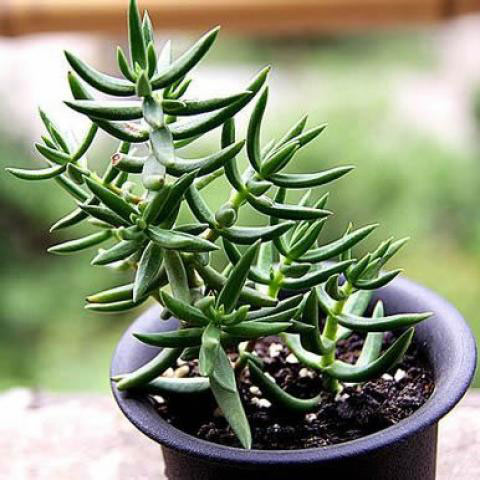
The stem cuttings can be placed in the soil in any manner because it will successfully root with adequate supplies of the caring parameters as long as the cutting has been done properly.
The leaf cuttings are also placed on the potting soil. Watering of the leaf cuttings is done when they are completely dry.
It will take 2-3 weeks for the succulent to start rooting if all the favorable parameters are received.
We have to follow the same process as stem cutting and the only difference is it takes a little longer compared to the stem cutting propagation. Literally, place them in the potting mix at first, then it is better to cover it until they sprout.
To separate the offsets from the mother plant, use a clean sharp knife. Gently divide the plant’s roots. Be sure to handle these tiny plants carefully to avoid damaging them. Allow the offsets to dry out for a few days. This ensures that any wounds callus, before planting them in succulent soil mix. Once you’ve placed the offsets into their own containers, be sure to keep them out of direct sun. Once they establish roots, you can immediately begin treating them just as you would a mature Miniature Pine Trees.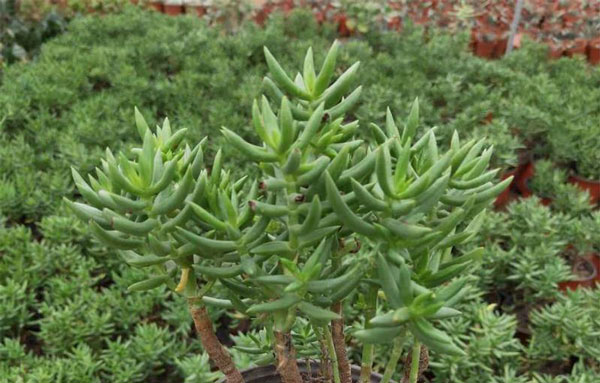
Humidity also plays a vital role in the Crassula Tetragona care. Plants in high dampness & cooler temperatures will require less continuous watering than plants in hot & dry atmospheres. A hygrometer can be used to estimate the moisture content in the soil thereby helping us in watering the plant.
When you do have to trim your Crassula, make sure to cut back the latest growth as close to where it joins with the older stems as possible.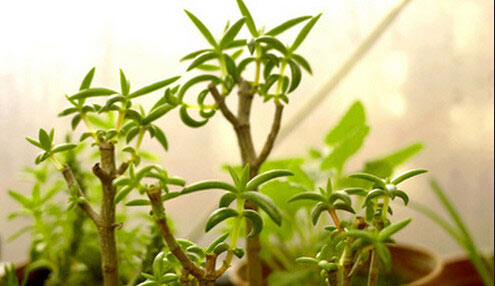
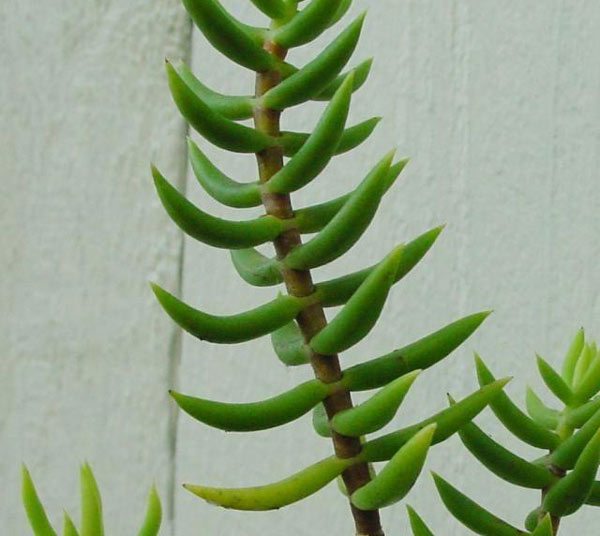
Crassula tetragona subsp. acutifolia, stems decumbent, rooting at internodes, and sharply acute leaf apices.
Crassula tetragona subsp. tetragona, plant with multiple erect branches, and densely flowered inflorescence.
Crassula tetragona subsp. rudis, plant with a single main erect branch, but loosely branched inflorescence.
Crassula tetragona subsp. connivens, young stems are papillose, rounded flower thyrse
Crassula tetragona subsp. lignescens, young stems are smooth, mature stems are woody, leaves relatively small. The most widespread subspecies.
Crassula tetragona subsp. robusta, young stems are smooth, stems all carnose, leaves are large and robust. The most commonly cultivated subspecies.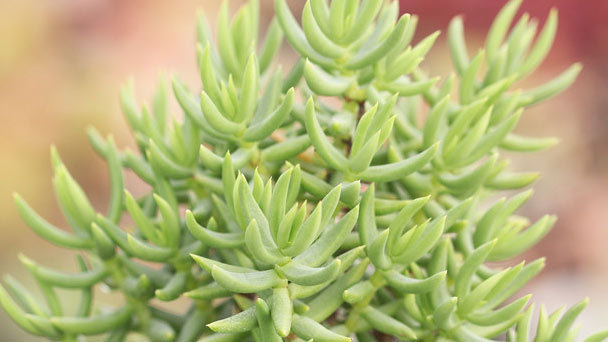
Mealybugs are the biggest pest threat to your succulents. They love to hide in crevices on your Crassula so be sure to inspect your plants regularly. If signs of mealy bugs appear in the form of a white cottony web or disfigured leaves, be sure to eradicate them immediately. These small white scale insects drink the sap out of plants and secrete honeydew that attracts ants. A Q-tip dipped in alcohol or a spray from an organic pest killing soap will do the trick. Read my complete post on mealybugs eradication here.
Aphids are less common but still a potential threat to Crassulas. Like mealybugs, they suck out the sap. If left untreated, they will eventually kill your succulent. Protect your echeveria by applying diatomaceous earth to the soil and neem oil to the succulent. Use insecticidal soap to control existing infestations.
Crassula Diseases
Make sure you never let your Crassula stand in water or else the chances of root rot and other fungal diseases will increase. Root rot is caused by consistent moisture and can lead to bacterial infections. The good news is that it is easy to prevent. Avoid overwatering and use a well-draining soil.
Root rot is best caught early, so routinely check for rot on your Crassula. Rotted sections will be brown or black and mushy. The rot usually starts in the roots and spreads up the stem. If you find an infected part, you'll have to remove it or else it will spread. After cutting away the rotted section, leave your succulent out of the soil for a few days so it can dry out and callous over. Repot in fresh well-draining soil and keep an eye on watering.
Crassula Sunburn
Brown spots may appear on your Crassula. These are most likely from sunburn. Move your plant out of direct heat to prevent further damage.
Crassula Tetragona PictureCrassula Tetragona InfoCrassula Tetragona Native HabitsCrassula Tetragona DistributionHow to Grow & Care for Crassula Tetragona How to Grow Crassula TetragonaHow to Care for Crassula TetragonaUses of Crassula TetragonaLandscape UseMedicinal UseVarieties of Crassula TetragonaCrassula Tetragona Common Pests/Diseases
Crassula Tetragona Picture

Crassula Tetragona Info
| Scientific Name | Crassula Tetragona |
| Common Name | Miniature Pine Tree |
| Plant Type | Succulent |
| Sun Exposure | Full Sun, Partial Sun |
| Height | 1'-3' / 0.3m - 0.9m |
| Width | 1'-2' / 0.3m - 0.6m |
| Bloom Time | Spring, Late Spring, Early Summer, Summer, Indeterminate |
| Origin | South Africa |
Crassula Tetragona Native Habits
The narrow, almost needle-like foliage and sparsely branched, shrubby, tree-like habit of this South African native have caused it to be misleadingly dubbed "miniature pine." In fact, Crassula Tetragona is an evergreen succulent closely related to jade plant (Crassula ovata). The apple-green, awl-shaped leaves of Crassula Tetragona occur in well-spaced pairs along fleshy upright stems that can reach waist height. Dense clusters of small creamy-white flowers appear at the branch tips in spring and summer.Like most succulents, Crassula Tetragona prefers fast drainage, whether grown in gardens or containers. Water it occasionally in summer, and sparingly in winter. Crassula Tetragona prefers full sun, but in hot climates requires midday shade. Crassula Tetragona will tolerate a couple of degrees of frost. Remove spent flower clusters to improve appearance and prevent seedlings (this species has escaped gardens in California via self-sowing). Potted plants may be kept indoors over winter, or grown as house plants.
Crassula Tetragona Distribution
Crassula Tetragona is a succulent plant native to Southern Africa. Crassula Tetragona is widely distributed from the Orange River boundary of Namaqualand to beyond the Kei River in the Eastern Cape.
How to Grow & Care for Crassula Tetragona
How to Grow Crassula Tetragona
- With Stem Cuttings
The stem cuttings can be placed in the soil in any manner because it will successfully root with adequate supplies of the caring parameters as long as the cutting has been done properly.
The leaf cuttings are also placed on the potting soil. Watering of the leaf cuttings is done when they are completely dry.
It will take 2-3 weeks for the succulent to start rooting if all the favorable parameters are received.
- With Leaves Cuttings
We have to follow the same process as stem cutting and the only difference is it takes a little longer compared to the stem cutting propagation. Literally, place them in the potting mix at first, then it is better to cover it until they sprout.
- With Offsets
To separate the offsets from the mother plant, use a clean sharp knife. Gently divide the plant’s roots. Be sure to handle these tiny plants carefully to avoid damaging them. Allow the offsets to dry out for a few days. This ensures that any wounds callus, before planting them in succulent soil mix. Once you’ve placed the offsets into their own containers, be sure to keep them out of direct sun. Once they establish roots, you can immediately begin treating them just as you would a mature Miniature Pine Trees.

How to Care for Crassula Tetragona
- Light
- Soil
- Water
- Temperature and Humidity
Humidity also plays a vital role in the Crassula Tetragona care. Plants in high dampness & cooler temperatures will require less continuous watering than plants in hot & dry atmospheres. A hygrometer can be used to estimate the moisture content in the soil thereby helping us in watering the plant.
- Fertilizer
- Pruning
When you do have to trim your Crassula, make sure to cut back the latest growth as close to where it joins with the older stems as possible.

Uses of Crassula Tetragona
Landscape Use
Crassula Tetragona is suitable for Container, Rock Garden & Xeriscaping.Medicinal Use
These plants are usually used as an ornamental, although they are believed to have been used as a medicinal plant by Thunberg, who wrote: "Crassula Tetragona, somewhat of an stringent nature, boiled in milk, in the quantity of a handful, is used as a remedy for diarrhea."
Varieties of Crassula Tetragona
There are at least 6 subspecies and cultivars that have been cultivated:Crassula tetragona subsp. acutifolia, stems decumbent, rooting at internodes, and sharply acute leaf apices.
Crassula tetragona subsp. tetragona, plant with multiple erect branches, and densely flowered inflorescence.
Crassula tetragona subsp. rudis, plant with a single main erect branch, but loosely branched inflorescence.
Crassula tetragona subsp. connivens, young stems are papillose, rounded flower thyrse
Crassula tetragona subsp. lignescens, young stems are smooth, mature stems are woody, leaves relatively small. The most widespread subspecies.
Crassula tetragona subsp. robusta, young stems are smooth, stems all carnose, leaves are large and robust. The most commonly cultivated subspecies.

Crassula Tetragona Common Pests/Diseases
They generally do not require a lot of maintenance. The bottom leaves will brown and die off as the Crassula grows, and this is normal. Be sure to remove these to keep the plant healthy and so that it does not attract pests like the evil mealybug.Mealybugs are the biggest pest threat to your succulents. They love to hide in crevices on your Crassula so be sure to inspect your plants regularly. If signs of mealy bugs appear in the form of a white cottony web or disfigured leaves, be sure to eradicate them immediately. These small white scale insects drink the sap out of plants and secrete honeydew that attracts ants. A Q-tip dipped in alcohol or a spray from an organic pest killing soap will do the trick. Read my complete post on mealybugs eradication here.
Aphids are less common but still a potential threat to Crassulas. Like mealybugs, they suck out the sap. If left untreated, they will eventually kill your succulent. Protect your echeveria by applying diatomaceous earth to the soil and neem oil to the succulent. Use insecticidal soap to control existing infestations.
Crassula Diseases
Make sure you never let your Crassula stand in water or else the chances of root rot and other fungal diseases will increase. Root rot is caused by consistent moisture and can lead to bacterial infections. The good news is that it is easy to prevent. Avoid overwatering and use a well-draining soil.
Root rot is best caught early, so routinely check for rot on your Crassula. Rotted sections will be brown or black and mushy. The rot usually starts in the roots and spreads up the stem. If you find an infected part, you'll have to remove it or else it will spread. After cutting away the rotted section, leave your succulent out of the soil for a few days so it can dry out and callous over. Repot in fresh well-draining soil and keep an eye on watering.
Crassula Sunburn
Brown spots may appear on your Crassula. These are most likely from sunburn. Move your plant out of direct heat to prevent further damage.
Latest Updated
- Benefits of Bugleweed - 7 Science-backed Health Benefits
- Bugleweed Dangers & Side Effects - Is It Poisonous?
- How to Plant Evergreen Trees - What You Should Know
- When to Plant Evergreens - Grow Guide for Evergreen Trees
- 12 Wonderful Evergreen Shrubs for Your Garden
- 12 Popular Evergreen Plants with Pictures for Beginners
- When And How To Prune A Lilac Bush Like a Pro
- How to Grow & Care for Lilac Vine (Hardenbergia Violacea)
- Japanese Lilac Tree (Syringa Reticulata) Care & Propagation Guide
- Shumard Oak Pros and Cons - What to Know
Popular Articles
- Winter maintenance of Antirrhinum Majus
- How to Grow Terminalia Mantaly Tree
- How to Grow and Care for Crossostephium Chinense
- How to grow Antirrhinum Majus in spring
- Peristeria Elata (Dove Orchid) Profile: Info & Care Guide
- Underwatered Snake Plant (Sansevieria Trifasciata) - Signs And How To Fix
- How to Care for Brazilian Jasmine Plant (Mandevilla Sanderi)
- How to Grow & Care for Graptopetalum Purple Delight in Summer
- Rosa Chinensis (China Rose): Plant Growing & Care Tips
- How to Care for Baby Sun Rose (Aptenia Cordifolia)